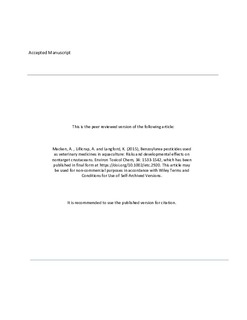| dc.contributor.author | Macken, Ailbhe | |
| dc.contributor.author | Lillicrap, Adam David | |
| dc.contributor.author | Langford, Katherine | |
| dc.date.accessioned | 2018-10-04T06:47:12Z | |
| dc.date.available | 2018-10-04T06:47:12Z | |
| dc.date.created | 2015-10-04T20:32:30Z | |
| dc.date.issued | 2015 | |
| dc.identifier.citation | Environmental Toxicology and Chemistry. 2015, 34 (7), 1533-1542. | nb_NO |
| dc.identifier.issn | 0730-7268 | |
| dc.identifier.uri | http://hdl.handle.net/11250/2566266 | |
| dc.description.abstract | Diflubenzuron and teflubenzuron are benzoylureas that are used in aquaculture to control sea lice. Flubenzurons have low toxicity to many marine species such as fish and algae but by their nature are likely to have significant adverse effects on nontarget species such as crustaceans and amphipods. Although the exact mechanism of toxicity is not known, these compounds are thought to inhibit the production of the enzyme chitin synthase during molting of immature stages of arthropods. These chitin synthesis inhibitors are effective against the larval and pre‐adult life stages of sea lice. Due to their low solubility and results of recent monitoring studies conducted in Norway, the sediment compartment is considered the most likely reservoir for these compounds and possible remobilization from the sediment to benthic crustaceans could be of importance. For this reason, the epibenthic copepod Tisbe battagliai was selected for investigations into the acute and developmental effects of these compounds. For comparative purposes, azamethiphos was investigated to identify differences in sensitivity and act as a negative control for developmental effects at environmentally relevant concentrations. Standard acute studies with adult copepods showed little or no acute toxicity at milligrams per liter levels with the flubenzurons, whereas a naupliar developmental test demonstrated that environmentally relevant concentrations (e.g., nanograms per liter) caused a complete cessation of molting and finally death in the exposed copepods. | nb_NO |
| dc.language.iso | eng | nb_NO |
| dc.publisher | Wiley | nb_NO |
| dc.title | Benzoylurea pesticides used as veterinary medicines in aquaculture: Risks and developmental effects on nontarget crustaceans | nb_NO |
| dc.type | Journal article | nb_NO |
| dc.type | Peer reviewed | nb_NO |
| dc.description.version | acceptedVersion | nb_NO |
| dc.source.pagenumber | 1533-1542 | nb_NO |
| dc.source.volume | 34 | nb_NO |
| dc.source.journal | Environmental Toxicology and Chemistry | nb_NO |
| dc.source.issue | 7 | nb_NO |
| dc.identifier.doi | 10.1002/etc.2920 | |
| dc.identifier.cristin | 1278266 | |
| dc.relation.project | Norges forskningsråd: 160016 | nb_NO |
| cristin.unitcode | 7464,20,13,0 | |
| cristin.unitcode | 7464,30,21,0 | |
| cristin.unitname | Økotoksikologi | |
| cristin.unitname | Miljøkjemi | |
| cristin.ispublished | true | |
| cristin.fulltext | postprint | |
| cristin.qualitycode | 2 | |
